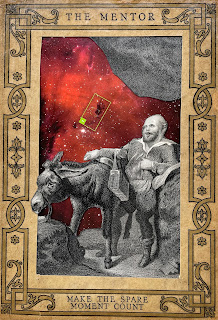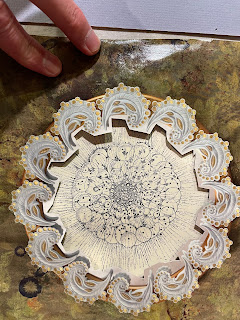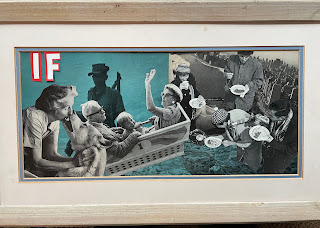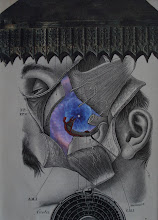I don't know the title of this piece (or the dimensions), but I LOVE this recent piece by my friend and fellow collage artist Anthony Morgan. Great color combinations, and use of transfer images...
Friday, December 31, 2021
Wednesday, December 29, 2021
backgrounds and "vibes"
As I have written many times, my collage process (like others, I presume) consists of lots of experimentation. In fact, trial and "error" (and lots of it), and experimentation, is what takes up most of my time in the studio. I LOVE it! Sometimes folks are surprised when I give a presentation and tell them that the vast majority of my collage compositions are not the end-product of some pre-conceived idea that I bring with me to the studio. I consider myself to be an experimenter, and perhaps more importantly, a "recognizer". I feel that I can recognize when elements coalesce into something worth pursuing. It is then that the process of honing and detailing begin. But that occurs late in the creative process. Here is a piece I have been working on over the last couple weeks. I especially wanted to share how changes in a background element, can change the entire "vibe" of a piece. My friend and fellow collagist, Anthony Morgan, always teases me about using so much "space" in the backgrounds of my works... so I thought I would include some of the other options I've tried here (although I will probably end-up with a galactic background in the end).
Thursday, December 23, 2021
"Good Advice"
Another end-of-the-year collage. The dimensions are 7" x 10". I have done some experimenting, and I think it will be surrounded with a dark blue mat. Interestingly, last night while I was doing the finishing touches, I made a "mistake" and put part of the donkey's head outside the 'mentor border'. As it turns out, I think it adds a lot to the composition (i.e., to have the nose go onto the border). Serendipity!
Sunday, December 19, 2021
"Cupid '97"
Here's the final piece. I entitled it "Cupid '97", because the base element is from a photograph from 1897 (copyrighted as well).
Sunday, December 5, 2021
teaser
Well... I'm always a bit hesitant about posting any "teasers" for up-coming pieces; but I really like the way some of these "sketches" started to emerge in the studio last night... so I'm posting. Stay tuned...
Friday, December 3, 2021
Anthony Morgan (toenyunknown), "Say His Name: Robert McDaniels 04.13.1937"
I've written about my good friend and fellow collagist a number of times on this blog as we have done a number of collaborative projects, and have exhibited together over the years. This post is all about him though. He did this very compelling piece recently, inspired by the Black Live Matter movement. He recently showed this work at Dirty Frank's in Philadelphia, and not only did it win "Runner-Up" in the show, but he got a wonderful write-up as well. Congratulations @tonyunknown
Sunday, November 28, 2021
finally a breakthrough
The summer of 2021 was one of the worst summers I have had in my life, for a number of reasons, upon which I don't need to elaborate too much. I take golf too seriously, and was having a bad season. Trying to remedy my golf game was taking up too much of my free time. In addition, for a number of reasons, I was experiencing a very serious "imposter syndrome" perspective about my music playing. Add those things to the continued stress that we're all experiencing as the pandemic keeps grinding on, and to my continued grief for my sister Kathy and my "baby girl" Frida (my dog who died one month after my younger sister), and it adds-up to Steve being in a hell of a funk for months. But I feel like I am finally "coming out of it"; and so, have been playing music a little bit and trying to get back into the studio to create some collage works. Of course, this semester has been a challenging one, since I am teaching two writing-intensive courses as well. BUT, this Thanksgiving weekend has allowed me a little bit of time to spend in the studio. With all that being said, I think I made a breakthrough this weekend! This piece is entitled "Certified Mary" (5" x 7"). It's a bit different than my usual style, and that's okay. If you have followed me at all over the years, you know that I am intrigued by thinking about the real life characters that I "meet" through my use of yearbooks or photos. The primary element in this piece is from an oversized diploma from Paradise Township in Pennsylvania (no doubt got this from the Farmersville auction). The transfer molecule came out well, in terms of the underlying patina of the diploma (the original paper was WAY too bright to be used as a regular element). I'm not "wow-ed" by this piece as the creator... but I feel very good about being bake to creating!
Sunday, September 5, 2021
composition and eye movements
Here's a REALLY good example of how integral psychology and neuroscience are to art perception. Viewers do not just "randomly" look at artwork -- eye movements are "controlled" by compositional elements.
detail decisions
While I was culling some of my recent photographs, I came across these variations and thought it might be interesting to post them. After finishing the primary composition for this collage, I contemplated placing the word "IF" as an additional element. I don't usually use much text in my compositions, but this piece was my half of a collage project for which my friend and fellow collage artist Anthony Morgan and I used only images from a single issue of LIFE magazine. I thought the "IF" from "LIFE" might be a nice addition. Even with this small component (detail) of the larger composition, there were variations to be considered. I ultimately decided to make the upper case "I" into a lower case "i" by adding a small red "dash". BTW, I have submitted this piece for this year's National Collage Society juried exhibit (wish me luck!)
Sunday, August 29, 2021
container decoration
A friend of mine bought a "tobacco container" called a dugout, and wanted me to decorate it. The first two images are the finished product. The others are some intermediates that I was considering. Funny how it works... I was seconds away from adhering the brain imagery, when I looked on the table and saw the flower element. When I placed it on the piece, I immediately changed my mind and went with the flower. Emergent properties! I have a forthcoming article in Kolaj magazine related to that concept.
Thursday, August 12, 2021
Collagist dilemma
I have a bit of a dilemma that I think some fellow collagists might appreciate. And perhaps "dilemma" is too strong of a word (I wish all my problems were this trivial, after all). I have a group of elements that I got years ago that are basically images of Vargas-type pin-up girls (I think "women" would be the better term). They are beautiful -- and larger than a typical magazine page (they are 9" x 12"). On the back of each page is a smaller, black-and-white version of the image along with information about the image. Here's the "dilemma". I have become interested in using the smaller (2.5 x 3.5"), black-and-white version of this particular element because it would fit perfectly into a background substrate I have found. The problem is that -- as an analog collagist -- if I use that image, I basically destroy the larger colored image. I am a "religious" analog collagist (self-imposed, arbitrary restriction, of course), so I won't photocopy the image for use (I know, it's somewhat silly, but I am dedicated to using only original elements). I'm explicitly not looking for any advise, but thought I would post as a point of interest, in terms of my creative process, perhaps ;-)
Friday, August 6, 2021
Friday, July 30, 2021
Chaos, Complexity, and Collage
I am hopeful that this essay will be published in the next issue of Kolaj magazine:
CHAOS, COMPLEXITY, and COLLAGE
Steven M. Specht, Ph.D., NCS
Despite extensive efforts by a number of psychological researchers over the decades, the cognitive complexities of “the creative process” has remained somewhat elusive. And of course, thinking about the creative process, as if it were a singular entity, is likely erroneous from the outset.
Nevertheless, a particularly pervasive, and persuasive model of creativity, initially posited by Donald Campbell in 1960, has since been extensively expanded upon by Keith Simonton and others, and involves a process referred to as “blind variation with selective retention” (BVSR). During this extensive process, a creator generates a variety of possible solutions to a problem (or options for a product, or piece of art, writing, or music), from which only a subset is ultimately retained for further consideration. For example, Simonton has shown that Picasso made a number of preliminary sketches of each of the various components of his classic painting Guernica, before eventually choosing which of the variations would be used in his finished composition. According to Simonton, the term “blind” in the BVSR model has been a bit problematic, however, because it can be misconstrued as “random”, rather than the accurate connotation of “unknowing” or, “unsighted”, in terms of the ultimate solution, or creative product. Another interesting feature of “blind” variations considered essential to creativity, is the non-monotonic nature of the process. That is, the progress of variation and subsequent retention is not necessarily linear. A creator might revert back to a variant that had been previously judged to be unworthy of retention – precisely because the end-product is “unknown” at the time any variant is considered. The process emphasizes artistic exploration in a dynamical system of creativity.
The title of the present paper could be misconstrued as well, in that my goal is to write about chaos not from a colloquial perspective, but rather, from a more technical/scientific perspective. That is, instead of referring to the dictionary definition of chaos as “a state of utter confusion”, or “a confused mass or mixture”, I will refer to chaos as it relates to “chaos theory” (although both perspectives might be relevant to collage as an artistic medium). Although many people are not specifically familiar with “chaos theory”, most people have heard of the “Butterfly effect” – the notion that something as seemingly insignificant as the flapping of the wings of a butterfly in Beijing, might ultimately affect the weather in Wyoming. The concept was popularized by computational meteorologist Edward Lorenz in the 1960s to underscore the fact that end-states of complex dynamical systems can be hypersensitive to the state of their initial conditions -- that simple changes can be multiplied and magnified over time to create substantial changes in the outcome of a dynamical process, like the weather. I contend that the creativity involved in making collages is a similarly complex dynamical process. Interestingly, the ultimate outcomes of even extremely complex systems are not necessarily unbounded, but may capitulate to a limited number of “strange attractors”. Some of the essential features of chaos theory are reminiscent of the “superpositions” suggested by quantum physics (i.e., the existence of simultaneously multiple states), the Heisenberg uncertainty principle, and the fate of Schrodinger’s cat! Only when initial conditions are assumed or defined, can the possible end-states of the system be anticipated. Conversely, only when the end-state is known, is it possible to identify, or describe the initial conditions. But in either case, complete a priori knowledge of the dynamical system is precluded.
But rather than going too deep into the scientific woods, I would like to re-focus on collage creation. I have scores of vintage Life magazines in my chaotic (dictionary definitional use) studio, as well as dozens of vintage books, including books about steam engines, anatomy, photography, insects, and history. Of course, I also have many contemporary magazines and books from which to choose potential collage elements. Although all of these sources seem quite static as they sit stacked on the floor or on bookshelves; they create the potential for an extremely complex dynamical system. What may seem like a random act of selection of an element, perhaps is not random at all, but determined by a myriad of slight perturbations in “initial conditions” of the artist and the environment (i.e., the studio milieu). Artists sometime refer to the role of “intuition” in their creative process. And in Simonton’s analysis, this may be one source of “blind variations”. I would suggest that intuition (as well as the stacks of vintage magazine) may be akin to the effects of flapping butterfly wings. When I descend into my studio, I may look out of the corner of one eye, and my attention is drawn to an issue of Life magazine from 1959: alternatively, I may turn my head, and my attention is drawn to a volume of Journal of Art from 1878. The course of my further explorations and experimentation in collage composition continues from one of those initial starting points (or any one of hundreds of starting points), which may ultimately influence the end-point of the process – that is, the collage that I create. But are those really the starting points – the initial conditions – of the complex dynamical system involved in creating a collage?
Flashback to a few years prior to this hypothetical episode in my studio…
… At the auction house in Lancaster, Pennsylvania (one of my favorite sources of material) I had spent an hour or more carefully surveying potential sources of collage material (and frames) among the lots about to be auctioned off. There wasn’t as much that day as I had seen in the past. But there were three volumes (from 1877, 1878, 1879) of The Art Journal, which contained scores of marvelous, high-quality, vintage etchings. I felt like I had to add them to the vast catalog of potential collage elements in my studio. Most items at this particular auction are sold very cheaply – a box of vintage Life magazines for $10; an ornate and illustrated Bible for $3; a vintage Sears & Roebuck catalog for $2. I expected to get the 3 Art Journal books for $15, perhaps. The bidding started and it became clear that I had competition with another bidder who appeared to be a vintage book buyer (even though these particular books were in “very poor” condition). A series of back-and-forth bidding ended with my successful bid of $220 for the books. Because the bid was unusually high, one elderly woman sitting next to me said, “people are looking at you like you’re crazy”. The box of etchings I extracted from those three books is one of my most prized possessions, in terms of potential collage elements. I have already created (and sold) several pieces which include elements from these sources. My artwork has been positively affected by that event, on that day. The flapping of a butterfly’s wings? What if I had gotten a flat tire that day, and arrived too late to the auction (or not at all)? What if I had overlooked those books? What if I had stopped bidding at $200? I certainly would still be creating collages. And neither I, nor anyone seeing my work, would even be aware of what “might have been”. But there is no doubt that the “initial conditions” of the complex system we call collage (and indeed, any creative endeavor) is affected by an ongoing, complex, cascade of personal events which ultimately define the end-products – for example, my purchasing those three books.
I am not so inclined to call these events random, however, simply because their complexities are difficult to identify. I do not randomly find myself at auction houses 5 hours from my home. I do not randomly bid on just any books and magazines. That is, these stochastic events do have some features which are defined by apparently limited realities -- and yet, the possible outcomes of such a system seem virtually unlimited.
Even when we intentionally limit the initial conditions, the complexity of collage creation becomes evident. Several years ago, I had the pleasure of participating in a collage project organized by Joel Lambeth called “The Power of N (where N = 10)”. For this project, 10 collagists from around the world were provided with identical packets of potential collage elements. The goal was to see what ten different artists would create after being given the same sources of elements. The results were as one might expect – a beautiful variety of quite distinct collage compositions; even though the same source materials were used. Recently, my friend and fellow collage artist Anthony Morgan and I decided that we would each create a collage (same dimensions) from the same issue of LIFE magazine (Oct. 6, 1965), without collaborating or discussing our progress. What emerged were two collages which represented two different “voices”, and which underscore the complexity of factors which contribute to the creation of collage compositions.
With no intent to demystify the deamons of creativity, I would propose that the “strange attractors” that we settle upon for our collage compositions emerge as the result of complex dynamical systems which are continuously being influenced by an infinitude of changes of “initial conditions” (which begin where?). In fact, the article that you are now reading could be considered emergent from my continual reflections of the collage-creating process.
Saturday, June 19, 2021
periodic hiatus
If you look back at previous posts on this blog, you will notice that my posting history is cyclical (sounds better than "sporadic", doesn't it?). I think it is natural, when you are not a "full-time artist", to do more creative endeavors when other responsibilities ebb and flow -- which they often do in academics. Interestingly (I suppose), the end of a LONG year-and-a-half of stressful teaching-during-COVID ended in the middle of May, and yet I have not been very active creatively or on this blog since. This time, unfortunately, my hiatus coincides with a bout of depression that I am experiencing. Strange how depression works. It's irrational, for sure. I have SO many thing NOT to be depressed about -- my life is generally pretty excellent. But alas. And so I am working things out, I hope. Last night was the first time I have been in the studio for a while; and I "re-entered" by doing one of the things I like to do -- looking through old stacks of individual pages I have ripped from magazines and books over the years. I ofetn have forgotten about interesting elements that I have collected over the years. I've made posts of these sessions before, and I think they're fun. So here's the latest installment.
Sunday, June 6, 2021
Chemistry and collage
Since I will be moving into a new office this fall in the new science center at Utica College, I have decided to do a "deep purge" of all the STUFF I have accumulated over the years. It's been a LONG time since I was an undergraduate chemistry major at Oswego State (I ended-up getting a degree in psychology; but used a lot of my chemistry background for my Ph.D. in psychobiology). Anyway, I decided that it was time to get rid of my intro. chemistry textbook and my organic textbook as well. Interestingly, the textbook I had for intro. chemistry included a make-shift stereoscope to look at the illustrations in the textbook of chemical structure to render them three-dimensional. Very cool idea, methinks! Unfortunately, I have very poor binocular vision; so it never really worked for me. Here are some of the illustrations that were created to make the 3-D effects. I cut them from the book as potential transfer images (and will probably share half with my friend and fellow collagist Anthony Morgan). Collage is always "pan-disciplinary"! Oh yeah, I also included this interesting "note to self", for fun.


























































